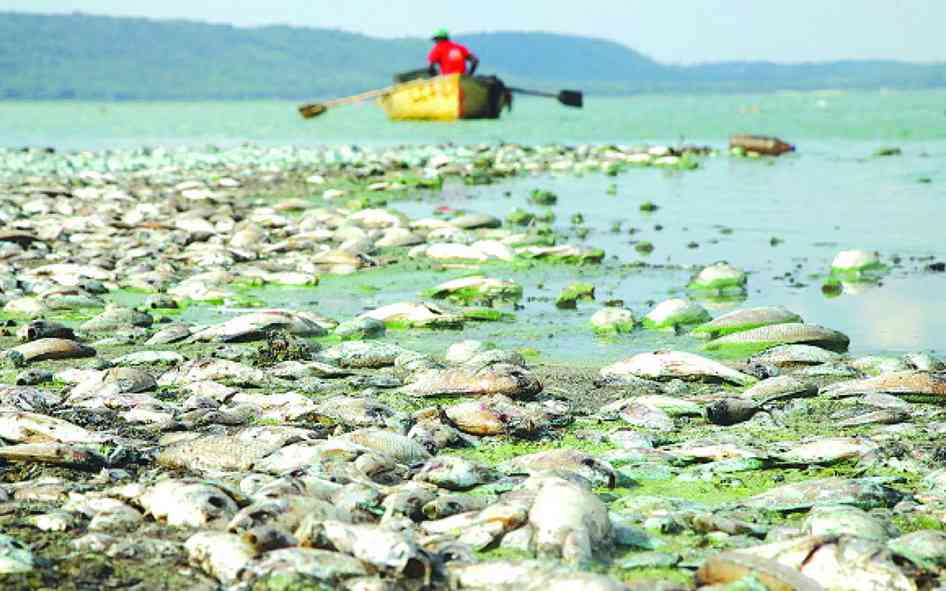
The stench tormented visitors long before the lake came into view after disaster struck Lake Chivero last year. A pungent, stomach — churning rot of death and decay floated on the still waters in the days that followed, as flies circled erratically over bloated fish carcasses.
The water body — once a shimmering sanctuary for wildlife and a vital water source for Harare’s estimated three million residents — is now a dying wetland.
It is a tragedy that has spiralled far beyond the visible surface, as latest developments show. This week, the Zimbabwe Parks and Wildlife Management Authority (ZimParks) revealed the full-scale of devastation.
It confirmed that animals were being led to alternative watering points because even wild beasts can no longer drink from Chivero.
“We have lost a zebra, wildebeest and impala,” ZimParks spokesperson Tinashe Farawo told the Zimbabwe Independent.
“But we did not do post-mortems to determine if it was due to cyanobacteria toxicity … We are just putting measures in place to try to protect our animals by availing alternative clean game water sources,” he said.
These were words with high impact.
If authorities are worried with the health of animals, humanity could be in grave danger.
- Veld fire management strategies for 2022
- Stop harassing media for reporting truth
- Veld fire management strategies for 2022
- News in depth: Mnangagwa’s push for $12 billion mining industry imperils communities
Keep Reading
The admission was chilling: wildlife — once free to roam and graze around the lake — are now refugees in their own habitat, driven away by the poisonous brew that Chivero has become. It is a damning indictment of human negligence that is common across many of Zimbabwe’s vital assets. And the blame lies squarely with a broken system.
Despite a blanket ban on fishing imposed in the wake of last year’s massive fish die-offs, fish from Chivero have continued to flood Harare’s markets.
For many, these fish are the cheapest source of protein. In formal markets, fish can only be accessed at high prices. But now, products from Chivero are also the most dangerous.
In December 2024, thousands of dead fish washed up on the lake’s shores, shocking the country. Cyanobacteria — also known as blue-green algae — was the suspected killer, according to official reports.
The toxic outbreak, linked to raw sewage runoff from the Marimba area, had poisoned entire bays, transforming Chivero into a graveyard for aquatic life. It is a rare phenomenon at Lake Chivero, but one that has always been anticipated.
Eagles and vultures circled overhead, feeding on the carcasses before retreating into the sky.
Beneath the surface, the crisis is deepening. The Independent was told that the Harare City Council is still pumping raw, untreated sewage directly into the lake. The council has faced a string of penalties from the Environmental Management Agency (EMA) — but the mess continues.
But the city is also taking action.
“We are continuously monitoring contamination of water,” EMA spokesperson Amkela Sidange said.
“Between 2021 and 2025, the City of Harare was issued seven tickets and seven environmental protection orders for various environmental offences … including discharge of partially treated and raw sewer into the environment,” the EMA official told the Independent.
Those failures are not just bureaucratic footnotes. Experts say they are the reason families across Harare are boiling water that should be clean.
They are also the reason why game rangers have had to bury wild animals. Experts say they are the reason leisure operators are in court fighting for compensation. And why drinking water in Zimbabwe’s capital is now a calculated risk.
When the Independent commissioned water samples last year, the results were frightening.
“Nitrates and manganese come from sewers … Turbidity provides a good environment for microbial growth,” the laboratory noted.
“The water cannot be used for cooking, though it can be used to wash vegetables.”
Washing vegetables was the best Harare’s water could offer at the time. It is not clear if this is the position today.
And still, despite this unfolding environmental disaster, the City of Harare delayed action on a tender to repair the Amalinda pipeline — a rotting artery in the city’s sewage network.
That pipeline alone discharges 80 million litres of waste daily into the Firle treatment plant, dangerously close to the Mukuvisi–Manyame confluence.
The US$16 million pipeline tender, awarded three years ago should have been fast-tracked. Instead, the bid was choked in red tape and riddled with controversy. Crucial bid documents went missing — sparking a probe by the Zimbabwe Anti-Corruption Commission.
While investigations dragged on, effluent continued to gush into Chivero’s already burdened waters. Fish floated belly-up. Animals became casualties of the environmental disaster. And Harare’s three million residents were left to navigate the fallout with buckets and boiling pots to ameliorate the crisis.
In May this year, the Procurement Regulatory Authority of Zimbabwe (Praz) gave the nod to finally proceed with the tender — pending due diligence. The recommended contractor, Water-Mark Technologies, will now attempt to rebuild what decades of neglect have eroded.
But the rot runs deeper than any pipeline.
“City of Harare took a long time to evaluate the tender and managed to submit for scrutiny by the Special Procurement Oversight Committee (SPOC), eight months later, on February 5, 2024,” the entity said in responses prepared for the Independent.
“Praz responded to the City of Harare on February 14, 2024, advising them to address shortcomings noted in their submission,” it added.
In another correspondence seen by this publication, dated May 28 and addressed to acting HCC town clerk Addmore Nhekairo, Praz recommended that:
“The accounting officer can proceed to award the … procurement contract to Water-Mark Technologies at an award sum of US$16 447 656,30 subject to further due diligence on prices before contract signature.”
The document shows that some of the entities that submitted bids include Max-Tech, which charged US$5,4 million, Sprint Engineering which pegged the price at US$10 million, CCGRP whose price was US$10,4 million, and Feodesic Engineering, which quoted US$10,5 million. The tender is payable in local currency at the official exchange rate.
Even rainfall — nature’s own purifier — has not been enough to wash the lake clean. Sidange confirmed that while recent rains had increased turbulence and oxygen levels in some catchments, the Upper Manyame Sub-Catchment — where Chivero sits — remains in distress.
It is bad news for a city in perpetual crisis. State power utility Zesa was recently said to have switched off Harare’s tower lights. Reports also indicated the city’s traffic lights, like those in other major towns, were next to be switched off.
“Manyame catchments continued to show lower dissolved oxygen saturation due to multiple factors, including urban pollution sources, industrial discharge, and high organic material loads,” the EMA official said.
Those “loads” are a polite way of saying human excrement.
The horror is not theoretical. ZimParks confirmed that a crash of white rhinos, four fish eagles, and multiple zebras and wildebeest have perished.
On nearby farms, livestock has died after drinking from streams fed by the poisoned lake.
At Kuimba Shiri Bird Park, one of Zimbabwe’s most celebrated leisure spots on Chivero’s banks, the impact has been devastating. The owners have taken Harare City Council to court, citing financial losses linked to the pollution.
One doesn’t need a lab report to see the damage taking place in Harare. They only need to stand by the water’s edge.
There, the murky lake lies still, its surface flecked with brown patches, and other signs of pollution.
Occasionally, a bloated tilapia breaks the surface and then drifts away. The air is thick, noxious. Fishermen no longer sing as they haul in nets, but they work silently, resigned to the risk.
And in Harare’s markets, the fish is sold anyway — some of it sliced, some of it fried, and all consumed by unsuspecting residents.
It is a quiet, slow-moving catastrophe. One that kills not with sudden explosions, but with cumulative negligence.
With every day that passes without repair, and with every litre of raw waste that is flushed into the lake’s waters, the situation calls for attention.
Experts say with every child who drinks the water, the situation in Harare is the kind of disaster that does not need to announce itself. It can only persist.






